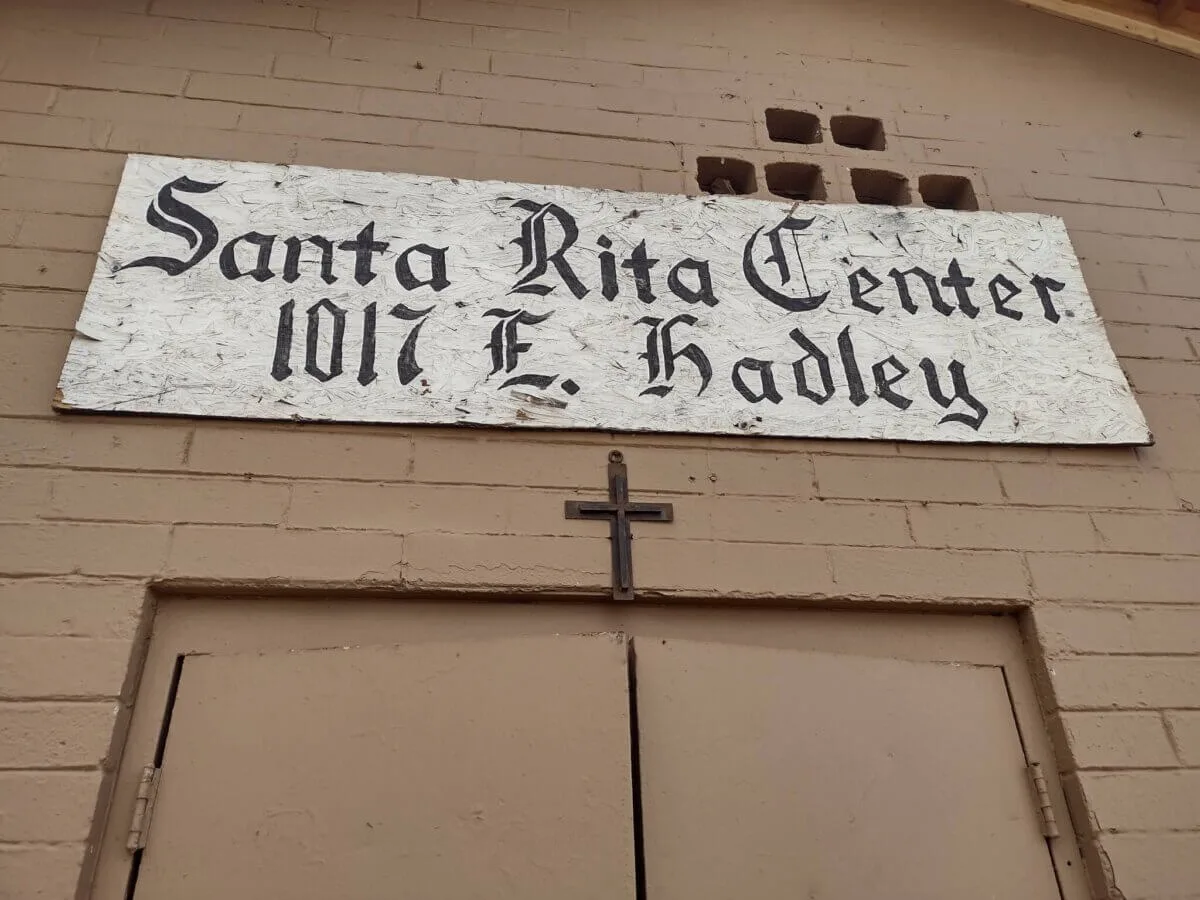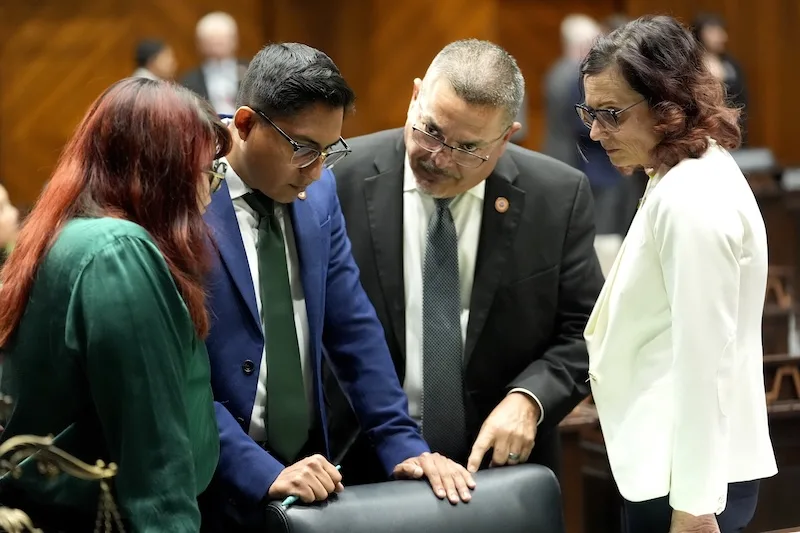
Santa Rita Center in Phoenix (Photo by Naomi DuBovis)
PHOENIX – A small building sits near 10th Street and Hadley Street. Houses and empty lots are all around. The area is quiet compared to the bustle of downtown Phoenix’s urban center, which can be seen from a couple miles away.
Above the front door of the building is a hand-painted sign reading “Santa Rita Center” in gothic script. Furniture and other odds and ends remain inside.
Some historic buildings are known for their architectural majesty. Santa Rita Center is known for the hands who built it and those who walked through its doors.
There are several other buildings like it: The Rosson House, The Hotel San Carlos, the First Baptist Church, and others. They all were built at different times and adopted different architectural styles, but they all serve to remind Phoenix of its past.
Preserving these buildings is a feat. Permits and reviews along with architectural planning and design maintain the structural integrity and character of each historic building in Phoenix. These efforts are all done with the goal of conserving relics of the city’s heritage.
Santa Rita Center
Sacred Heart Parish in Phoenix built Santa Rita Center in 1957.
Maria Elena Coronado-Sutter, a Chicanos Por La Causa (CPLC) scholarship program co-coordinator, said the diocese lent the building to CPLC in 1969.
Coronado-Sutter said it became a place for those in the neighborhood to have quinceañeras, weddings, baptisms, and other social events.
“This is also where they came to have a morning breakfast,” she said. “This is where they did the morning menudo after Sunday mass. Like, people knew that they could come here.”
Coronado-Sutter also said that CPLC’s roots as an organization have a strong connection with Santa Rita Center.
“The more important part of it, and we try not to forget, is that this was their birthplace here,” she said. “This was critical to their formation.”
Santa Rita Center is also connected to civil rights activist César Chávez, who famously held a 24-day fast on May 11, 1972, to protest working conditions of farmers. Chávez started the fast in Santa Rita Center, turning the hall into a landmark for Chicano history.
The hall is undergoing structural repairs and additions to make it a center for CPLC operations and special events.
These improvements don’t start overnight—getting a project like this off the ground requires a great deal of administrative work beforehand.
The Administration of Historic Preservation
According to Phoenix Planning and Development, a historic property “must be at least 50 years old; it must demonstrate historical significance; and it must possess historic integrity.”
The department defines historical significance as a building’s artistic value or tie to a significant historic event or person. Integrity is determined by “location, design, setting, materials, workmanship, feeling and association.”
Helana Ruter, the acting historic preservation officer for the city of Phoenix, said her office is responsible for survey work to identify properties eligible for historic designation. Santa Rita Center was added to the Phoenix Historic Property Register in October 2007.
According to Ruter, any property in this register is protected by overlay zoning, meaning that anyone who wants to make changes to the building’s exterior must apply for a permit.
Phoenix’s zoning ordinances outline other projects that need approval, including destroying, moving, or making any significant structural, architectural, or mechanical change to a historic building. Ruter said the office conducts design reviews for permit applications.
According to Phoenix Planning and Development, minor changes can gain approval through a Certificate of No Effect, a form stating that the work won’t affect the building’s historic character.
A Certificate of Appropriateness is required if the work is more complicated or visible from the street. To obtain this form, a historic preservation planner meets with the applicant and may even hold a public hearing. From there, the acting historic preservation officer decides whether to approve the project.
Design, Architecture of Historic Sites
Preserving a historic building comes with several considerations, including what to restore, what to replace, and how to make proper repairs without destroying the building’s character.
Jerry Cook is a historic preservation architect overseeing Santa Rita Center’s revitalizations. He said the changes will turn the building to a fully functional meeting space and event center with a museum dedicated to Cesar Chavez.
But before all of that could happen, there were issues with the building’s construction that had to be addressed.
Cook said the building’s original trusses were falling apart, since they were made up of several pieces of wood nailed together. The truss of a building is a frame piece designed to hold up a roof, so this meant that Santa Rita Center needed a new roof installed.

According to Cook, situations like these create the challenge of balancing the need for repair with the need to preserve the building’s original materials.
“Even when you can’t save all of it, you strive to save pieces of it so you can demonstrate to future generations this was the love and care that went into this facility that these people built,” he said.
To do this, Cook said that some original trusses in the roof will be placed alongside the new ones, and windows will be placed to maximize their visibility. The trusses removed from the roof will be part of a mount or other display piece.
Cook also said that buildings often change over time, and architects must decide which changes from which time period are reflected in the building’s appearance.

He mentioned two important time periods for Santa Rita Center: the era of its original construction in the late 1950s and the Cesar Chavez era starting in the early 1970s. With this in mind, the question becomes which era to bring the building back to.
Particular features of the building can make this decision even more complicated when no one knows when they became part of the space.
One such feature of Santa Rita Center, according to Cook, is a faded yin-yang picture on the floor. The time period in which it was created is unclear, so its inclusion in the final design has yet to be determined.
Why Preservation Matters
Place Economics, a firm that analyzes the economic impacts of historic preservation, outlined its benefits for Phoenix in a study released last year.
“One of the big goals in the Preservation Phoenix Style study was to demonstrate the benefits of preservation, adaptive reuse, how it contributes to small business and legacy businesses, which really contribute a whole other character and faction of the economy that might not otherwise have been noticed,” Ruter said.
The study stated that investment in rehabilitation and construction projects for historic properties added jobs to the market.
“People working directly on construction and rehabilitation projects in historic districts have collectively received paychecks averaging $2,924,000 in each of the last twenty-one years,” the study said. “Labor income spurred by this investment (indirect and induced economic activity) added an additional $909,000 into the pockets of Phoenix residents.”
The study also found that residents of historic districts are more connected to work, schools, clinics, and other important places in the city. This is largely because these districts are more walkable and transit-friendly.
The study measured walkability in a Walk Score, which is scaled from zero to 100. Phoenix’s average score is 41, meaning that most errands require a car.
Historic neighborhoods overall had an average Walk Score of 64, and most of the individual districts had a score greater than 70. That means that someone living in a historic district can do most of their errands on foot.
In addition to walkability, the study said that historic districts have a greater sense of social cohesion than other parts of Phoenix, since most historic neighborhoods have established community organizations.
Many of Phoenix’s most iconic cultural landmarks are designated as historic, the study said, adding to the uniqueness residents associate with a Phoenix identity.
According to Coronado-Sutter, preserving Santa Rita Center will turn it into the social and cultural hub that brought people together in the past.
“There are people who are really just tied into the nostalgia of this community and what they remember, and I think bringing some of these whole new elements in will reignite a lot more interest,” she said.
If nothing else, Cook said that historic buildings represent a shared cultural heritage that should not be forgotten.
He said, “The more of that we lose, the less we have of ourselves.”
Looking for the latest Arizona news? Sign up for our FREE daily newsletter.
Politics

Democrats clear path to bring proposed repeal of Arizona’s near-total abortion ban to a vote
Democrats in the Arizona Senate cleared a path to bring a proposed repeal of the state's near-total ban on abortions to a vote after the state's...

It’s official: Your boss has to give you time off to recover from childbirth or get an abortion
Originally published by The 19th In what could be a groundbreaking shift in American workplaces, most employees across the country will now have...
Local News

Kari Lake calls on Arizona county sheriffs to enforce 1864 abortion ban
Republican candidate for US Senate Kari Lake on Saturday seemed to solidify her support for Arizona’s total abortion ban and called on county...

Where to buy farm-fresh eggs in Tucson
Once you’ve tasted farm-fresh eggs, it’s hard to go back to the store-bought variety. Not only do farm-fresh eggs taste better and have...





